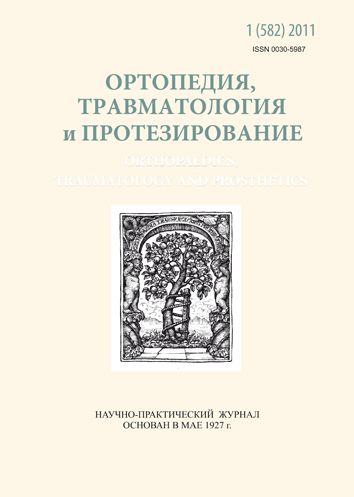A study of the influence of glucosamine hydrochloride compounds on certain links of connective tissue metabolism and inflammatory processes in corticosteroid osteoarthrosis modelling
DOI:
https://doi.org/10.15674/0030-59872011177-80Keywords:
cartilage, blood, tyrosine, hexosamine, inflammation, biochemistry, experiment, glucosamine hydrochloride, acetylsalicylic acid, osteoarthritisAbstract
The article describes results of as biochemical study of changes in the content of articular cartilage matrix macromolecules in cartilaginous tissue, as well as markers of inflammatory processes and alkaline phosphatase activity in blood serum of rats with a model of corticosteroid dystrophy under the influence of their treatment with compounds of glucosamine hydrochloride plus glucosamine acetylsalicylate with ratios 2:1, 1:1 and 1:2 by weight and a dose of 100 mg/kg. It was found out that in ratios of 2:1 and 1:1 the above compositions produced more pronounced effects to stimulate, in the cartilage matrix, the accumulation of carbon-protein compounds, assessed by the content of hexosamines, and noncollagenous proteins, determined by the content of thyrosine. Data of biochemical studies of blood serum demonstrated reduction in the inflammatory process activity. In order to develop a new antiarthrotic drug with combined chondroprotective and anti-inflammatory effects, a composition with a ratio of 1:1 by weight is recommended.
References
- Камышников В.С. Клинико-биохимическая лабораторная диагностика: справочник в 2-х т. Т.1 / В.С. Камышников. — Минск: Интерсервис, 2003. — 495 с.
- Лапач С.Н. Статистические методы в медико-биологических исследованиях с использованием Exel / С.Н. Лапач, А.В. Губенко, П.Н. Бабич. — К.: Морион, 2000. — 320 с.
- Остеоартроз. Консервативная терапия / Н.А. Корж, А.Н. Хвисюк, Н.В. Дедух и др.; под ред. Н.А. Коржа, Н.В. Дедух, И.А. Зупанца. — Х.: Золотые страницы, 2007. — 424 с.
- Слуцкий Л.И. Биохимия нормальной и патологически измененной соединительной ткани: монография / Л.И. Слуцкий. — Л.: Медицина, 1969. — 375 с.
- Antioxidants block cyclic loading induced chondrocyte death / B.R. Beecher, J.A. Martin, D.R. Pedersen et al. // Iowa Orthop. J. — 2007. — Vol. 27. — P. 1–8.
- Boas N.F. Metod for the determanation of hexosamines in tissues / N.F. Boas // J. Biol. Chem. — 1953. — Vol. 204, № 2. — P. 553–562.
- Decreased metalloproteinase production as a response to mechanical pressure in human cartilage: a mechanism for homeostatic regulation / J. Monfort, N. Garcia-Giralt, M.J. López-Armada et al. // Arthritis Res. Ther. — 2006. — Vol. 8, № 5. — P. 149.
- Gray R.G. Intra–articular corticosteroids. An Updated Assessment / R.G. Gray, N.L. Gottlieb // Clin. Orthop. Rel. Res. — 1983. — № 177. — P. 235–263.
- Ishiguro N. Role of aggrecanase and MMP in cartilage degradation / N. Ishiguro, T. Kojima // Clin. Calcium. — 2004. — Vol. 14, № 7. — P. 38–44.
- Mechanical injury potentiates proteoglycan catabolism induced by interleukin-6 with soluble interleukin-6 receptor and tumor necrosis factor alpha in immature bovine and adult human articular cartilage / Y. Sui, J.H. Lee, M.A. DiMicco et al. // Arthritis Rheum. — 2009. — Vol. 60. — P. 2985–2996.
- Mechanisms and kinetics of glycosaminoglycan release following in vitro cartilage injury / M.A. DiMicco, P. Patwari, P.N. Siparsky et al. // Arthr. Rheum. — 2004. — Vol. 50, № 3. — Р. 840–848.
- The effect of glycosaminoglycan loss on chondrocyte viability: a study on porcine cartilage explants / S. Otsuki, D.C. Brinson, L. Creighton et al. // Arthritis Rheum. — 2008. — Vol. 58, № 4. — P. 1076–1085.
- The reverse glucosamine sulfate pathway: application in knee osteoarthritis / G. Herrero-Beaumont, L.C. Rovati, S. Castaneda et al. // Expert. Opin. Pharmacother. — 2007. — Vol. 8. — P. 215–225.
Downloads
How to Cite
Issue
Section
License
Copyright (c) 2014 Svitlana Osadchenko

This work is licensed under a Creative Commons Attribution 4.0 International License.
The authors retain the right of authorship of their manuscript and pass the journal the right of the first publication of this article, which automatically become available from the date of publication under the terms of Creative Commons Attribution License, which allows others to freely distribute the published manuscript with mandatory linking to authors of the original research and the first publication of this one in this journal.
Authors have the right to enter into a separate supplemental agreement on the additional non-exclusive distribution of manuscript in the form in which it was published by the journal (i.e. to put work in electronic storage of an institution or publish as a part of the book) while maintaining the reference to the first publication of the manuscript in this journal.
The editorial policy of the journal allows authors and encourages manuscript accommodation online (i.e. in storage of an institution or on the personal websites) as before submission of the manuscript to the editorial office, and during its editorial processing because it contributes to productive scientific discussion and positively affects the efficiency and dynamics of the published manuscript citation (see The Effect of Open Access).














